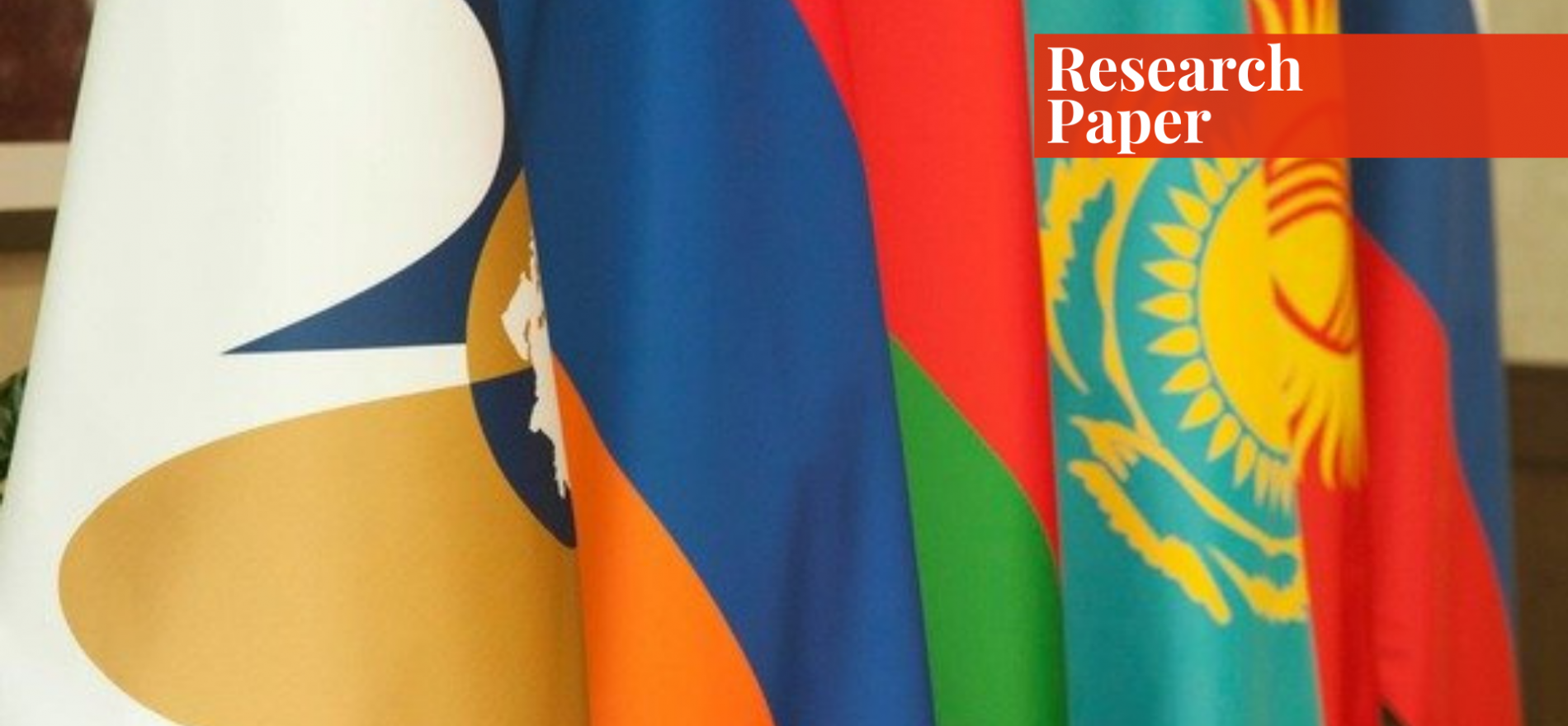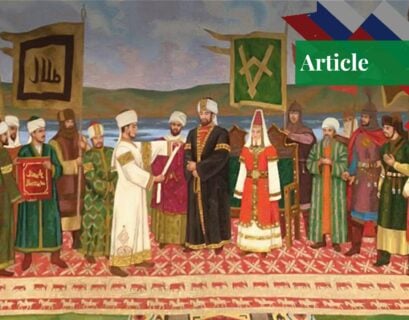Mr. Muhammad Jamal Akbar is a graduate of International Relations from Quaid-e-Azam University. He loves to write his thoughts and think with a cup of tea. He can be reached at [email protected].
Introduction
The Eurasian Economic Union (EAEU) is an international organization established by Russia in 2015 and its members include Armenia, Belarus, Kazakhstan, Kyrgyzstan, and Russia. This organization was built on the ground of economic integration and access to the whole world to create free trade area.
After the dissolution of the USSR, Central Asia emerged as the center of attention due to its natural resources such as oil and gas; these states are Kazakhstan, Uzbekistan, Kyrgyzstan, Tajikistan, and Turkmenistan. The geographic and geopolitical importance of it is that it connects with Asia and Europe.1 Central Asia has been under the influence of Russia, but major powers like China, the United States, and the European Union provide great challenges towards power politics.
Historical Background
In December 1991, the leaders of Russia, Ukraine, and Belarus met together to attempt economic and political integration, which lead to the creation of the Commonwealth of Independent States (CIS). Most of the republics from the dissolution of the USSR also joined CIS as members or associate member states. The inefficiency of CIS failed to play an effective role in the region which then resulted in political and ideological war and conflicts among its member states.2
Although many small regional level attempts were made such as the 1994 Free-Trade Zone, it never came into force due to Russia’s refusal to ratify the plan. The major change occurred in 2000 when Russia, Kazakhstan, and Belarus created the Eurasian Economic Community with Kyrgyzstan and Tajikistan as other members.
The aim was to create the Customs Union (CU) that usually indicates free trade between certain states but with a common external tariff. This community was created in Astana, Kazakhstan to serve economic and trade cooperation. In 2010, the CU was renewed and the countries agreed to form a common code for domestic laws, and in 2012, these states signed an agreement and create the Single Economic Space.
The goal of the Single Economic Space was to create one market in which goods, services, and capital could move freely, and thus lead to the creation of the Eurasian Economic Union. The initiative was taken by President Vladimir Putin to take a step towards the stabilization of the region.
While making it an economic union, the idea was to influence Central Asia on its political, cultural, and security grounds. It is believed that President Putin wanted to regain the lost influence and territory of the former Soviet Union states. Belarus and Kazakhstan supported the idea of a single body.
The then Kazakhstan President Nursultan Nazarbayev took it as an opportunity because his government was doing considerably well, and commented on it as a bridge between the economies of the EU, West, and Asia.3 In May 2014, the treaty was signed between these three states and on 1st January 2015, it came into force. Armenia and Kyrgyzstan later joined the treaty.

Kyrgyzstan joined in December 2014 because of security and trade concerns,4 since it suffered from the civil war after independence became a hurdle for its economy to flourish. Armenia, too, joined in 2014 mainly because of the border conflicts with Azerbaijan.5 Armenia had been given the opportunity to join the European Union, but it instead joined the Eurasian Economic Union.6
Structure of the Eurasian Economic Union
The Eurasian Economic Union operates through supranational and intergovernmental institutions, with the heads of the member states running the Supreme Eurasian Economic Council. Each year, a member state heads the Union; presently, Kazakhstan presides the Union until 31st December 2021. The Court of EEU is also very important as it assists in dispute resolution and enforces legal decisions. Two judges of each member state are appointed for 9 years.
The Supreme Eurasian Economic Council is the most important and active body, which allocates the budget, distributes the contribution of the member states, and formulates major strategies and directions that reflect the goal of the union. The Council has its own Eurasian Economic Commission that monitors the subordinate branches and advisory bodies. It consists of two bodies: Council and Board.
The Council consists of Vice Prime Ministers, responsible for the management of the Commission. It approves the draft for budget, the number of personnel, and qualifications for the employees. It also holds important issues such as issuing the customs and held business meetings. The Board is the executive body of the Commission, with the Chairman and 12 commissioners. It monitors the implementation of the treaty, submits annual reports, and makes recommendations.7
Eurasian Economic Union and Central Asia
To divert the Central Asia region from internal conflicts, Russia made agreements of free trade zone with other countries globally so as to indulge the region. In 2015, agreements with Mongolia were made to improve economic trade by removing trade barriers. Moreover, India has been active in Central Asia, with Prime Minister Modi signing a free trade agreement with the Eurasian Economic Union.8
There is no doubt that the market in Central Asia is attracting the globe due to the abundance of its natural resources. Kazakhstan and the Kyrgyz Republic have made it possible to sustain the Eurasian Economic Union. However, Uzbekistan and Turkmenistan have never been in favor of the Eurasian Economic Union because they perceive it as Russia seeking to dominate the region.

Initially, it had been difficult for the Kyrgyz Republic to join the Eurasian Economic Union, since it had joined the World Trade Organization (WTO) in 1998, which benefitted up to 15% of its labor migrant force, but, in 2015, Russia faced sanctions and the Russian ruble plunged, affecting Kyrgyzstan, for it traded more than 50% with Russia. The Kyrgyz NGOs and corporations showed disapproval of the idea of joining the Eurasian Economic Union.
However, President Atambayev advanced that joining the Eurasian Economic Union would promote the future development of the people of Kyrgyzstan. Between 2015 and 2016, more than 25% of Kyrgyz migrants were in Russia as a labor force, which assisted 30% of Kyrgyzstan’s total GDP. After joining, Kyrgyzstan saw a 22% rise in its GDP, which was a total of $1.6 billion.
The Eurasian Economic Union provides the member states with resources at reasonable and discounted prices. Belarus, too, was exporting oil from Russia at a price of $30 per tonne. Belarus made a total profit of $7 million between 2012 and 2015, which allowed them to recover from the 2011 crisis; the GDP increased by 5.5%, and industrial production increased by 9.1%.9
Main Actors
The Russian-led Eurasian Economic Union may have been created for economic assistance on paper, but directly, and even indirectly, Russia employs the Union to maintain influence in the political spheres of the states in Central Asia and to counter China and the West in the international arena. The geographic situation of Central Asia makes the area one of extensive worth, both for security concerns and resource potential.
The trajectory that the countries of this region collectively or independently draw towards will have a noteworthy effect on international strategy issues of incredible interest to the United States. Moreover, there have been signs that countries are seeking to rely on the United States to free themselves from Russia.10
America is looking for a more extensive geopolitical impact in Eurasia and regulation of political rivals and opponents such as China, the European Union, and Russia. Its approach is intended to propagate America’s mastery over the global financial and economic framework of Central Asia.
Although many view China’s relations with Central Asia as hegemonic, China doesn’t seem to have such intentions. China’s policies are only of the nature of trade, not of absolute control. The oilfields created between 2003 and 2009 were game-changers that were sent to China from western Kazakhstan. China also initiated a gas pipeline with Turkmenistan in 2009, and by 2013, China’s investment in Central Asia reached more than $50 billion.10
Challenges for the Eurasian Economic Union
The member states of the Eurasian Economic Union lack internal integration, both on political and social fronts. These states were unprepared for independence from the Soviet Union and so lack experience; presently, these states either have authoritarian governments or pseudo-democracies.
Another obstacle that hinders the progress of the Eurasian Economic Union is the lack of recognition and support from international actors; many outside actors are observing the progress and development of the Union, and Russia playing a dormant role with its feeble policies has been very strongly condemned. This criticism has come especially after the Ukrainian crisis.
Another emerging obstacle is that China through its soft power is allegedly trying to disturb the balance and territorial integrity of Russian dominance. Although the two countries pose for their partnership to counter the West, they do face conflicts which may raise the atmosphere of conflict between the two and shake the very core of the Eurasian Economic Union.
Owing to China’s new aims such as the Silk Road, economic belt, and construction of pipelines, Central Asia is getting extremely connected to China and even the whole globe. China is not posing any direct threats; however, its growing footprint and soft power influence in the region is diverting the attention of Central Asians towards another stronger and more reliable option.
Conclusion
The powers of the world such as China, America, Russia, and the European Union are looking forward to somehow influence Central Asia because of the region’s natural resources and minerals. For Central Asia, it is important for member states to politically stabilize themselves and make efforts to secure the region lest they face the disintegration of the Eurasian Economic Union.
Eurasian Economic Union’s intentions are quite ambivalent; it is very much possible that Russia uses the body to make an economic and international impact for itself, which is why many Central Asian states are wary of the Union.
Endnotes
1 Mustafa, Golam; Monowar Mehmood. “Eurasian Economic Union: Evolution, challenges and possible future directions.” Journal of Eurasian Studies, july 2018: 163-172
2 https://mfa.gov.by/en/mulateral/organization/list/aa16658947a49c28.html
3 Alberto Turkstra. “Central Asia in the Age of Connectivity.” EuropeNow, 2018.
4 “The Eurasian Economic Union: Power, Politics and Trade.” Crisis Group, july 2016.
5 Tisdall, Simon. “Azerbaijan-Armenia conflict is a reminder of Europe’s instability.” The Guardian, 2016.
6 Kassab H.S. (2018) Neoempires under Construction: The European Union and Eurasian Union. In: Grand Strategies of Weak States and Great Powers. Palgrave Macmillan
7 https://www.un.org/en/ga/sixth/70/docs/treaty_on_eeu.pdf
8 Joshi, Nirmala. “India’s Engagement with the Central Asian Republics: An Appraisal.” Indian Foreign Affair Journal, 2017: 133-146.
9 https://www.sciencedirect.com/science/article/pii/S2405473917300041
10 Blank, Stephen J. U.S. INTERESTS IN CENTRAL ASIA AND THE CHALLENGES TO THEM. Strategic Studies Institue, 2007.
11 Thrassy N. Marketos, China’s Energy Geopolitics, 2009
Bibliography
- Alberto Turkstra. 2018. “Central Asia in the Age of Connectivity.” EuropeNow.
- Blank, Stephen J. 2007. U.S. INTERESTS IN CENTRAL ASIA AND THE CHALLENGES TO THEM. Strategic Studies Institue.
- Mustafa, Golam; Monowar Mehmood. 2018. “Eurasian Economic Union: Evolution, challenges and possible future directions.” Journal of Eurasian Studies, july: 163-172.
- 2016. “The Eurasian Economic Union: Power, Politics and Trade.” Crisis Group.
- Tisdall, Simon. 2016. “Azerbaijan-Armenia conflict is a reminder of Europe’s instability.” The Guardian.
- Kassab H.S. (2018) Neoempires under Construction: The European Union and Eurasian Union. In: Grand Strategies of Weak States and Great Powers. Palgrave Macmillan, Cham
- https://www.un.org/en/ga/sixth/70/docs/treaty_on_eeu.pdf
- Joshi, Nirmala. “India’s Engagement with the Central Asian Republics: An Appraisal.” Indian Foreign Affair Journal, 2017: 133-146.
- https://www.sciencedirect.com/science/article/pii/S2405473917300041
- Dobrinsky R, Adarov A, Bornukova K, Havlik P, Hunya G, Kruk D, & Pindyuk O (2016). The Belarus Economy: The Challenges of Stalled Reforms. wiiw Research Report No.413. The Vienna Institute for International Economic Studies, Vienna, Austria, Vienna, Austria.
If you want to submit your articles and/or research papers, please check the Submissions page.
The views and opinions expressed in this article/paper are the author’s own and do not necessarily reflect the editorial position of Paradigm Shift.



















